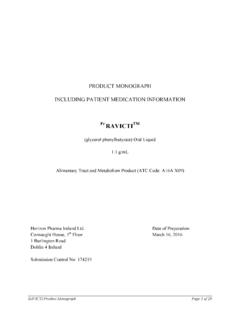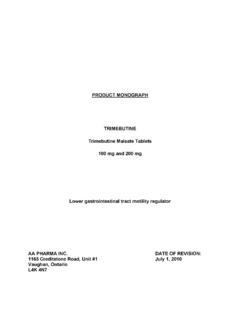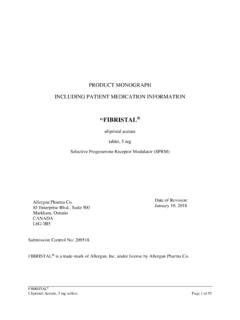Transcription of PRODUCT MONOGRAPH - Paladin Labs Inc.
1 PRODUCT MONOGRAPH PrMONUROL Fosfomycin powder, 3g/sachet (as fosfomycin tromethamine) Antibiotic Paladin Labs Inc. Date of Preparation: August 10, 2017 100 Alexis-Nihon Blvd., Suite 600 St-Laurent, Qu bec, Canada Version H4M 2P2 Submission Control No: 203904 MONUROL PRODUCT MONOGRAPH Page 2 of 25 PrMONUROL fosfomycin powder, 3g/sachet (as fosfomycin tromethamine) Antibiotic ACTION AND CLINICAL PHARMACOLOGY MONUROL (fosfomycin tromethamine), a phosphonic acid derivative is the mono-acid salt of fosfomycin with tromethamine. Fosfomycin is bactericidal in urine at therapeutic doses. Its bactericidal action is due to inactivation of the enzyme enolpyruvyl transferase, thereby blocking the condensation of uridine diphosphate-N-acetylglucosamine with p-enolpyruvate, one of the first steps in bacterial cell synthesis. It also reduces adherence of bacteria to uroepithelial cells.
2 Following oral administration, fosfomycin tromethamine is converted to the free acid, fosfomycin, which is rapidly absorbed. After a single dose of MONUROL (equivalent to 3 g fosfomycin), the mean maximum serum concentration (Cmax) achieved within 2 hours is g/mL in fasted subjects. Absolute oral bioavailability of fosfomycin under fasting conditions is 37% and 30% under fed conditions. When MONUROL is given with a high fat meal, the mean Cmax achieved is g/mL within 4 hours. The mean half-life for elimination (t ) in serum is hours without food and hours with food. Fosfomycin is widely distributed in body tissues and is not bound to plasma proteins. Following a 50 mg/kg dose of fosfomycin, a concentration of 18 g/gram in bladder tissue is achieved at 3 hours after dosing. Fosfomycin has been shown to cross the human placental barrier. Fosfomycin tromethamine is not metabolized and is excreted unchanged in urine and feces.
3 Following oral administration of MONUROL to fasted patients, the total body clearance (CLBT) and mean renal clearance (CLR) of fosfomycin are L/hr and L/hr respectively. Approximately 38% of a MONUROL dose (equivalent to 3 g of fosfomycin) is recovered from urine and 18% is recovered from feces. A mean maximum urine fosfomycin concentration of 706 g/mL is attained within 2-4 hours after a single oral dose of MONUROL (equivalent to 3 g of fosfomycin) under fasting conditions. Following a high fat meal, a mean maximum urine fosfomycin concentration of 537 g /mL is attained within 6-8 hours. The cumulative amount of fosfomycin excreted in the urine is approximately the same under fed and fasting conditions and urinary concentrations greater than 10 g/mL are maintained for 72-84 hours. In patients with varying degrees of renal impairment (creatinine clearance ranging from mL/min to mL/min), the t of fosfomycin has been shown to increase from 11 hours to 50 hours.
4 The percentage of fosfomycin recovered in urine decreases to 11% indicating that renal impairment significantly decreases the excretion of fosfomycin. However, urinary concentrations of fosfomycin remain greater than 100 g/mL for at least 48 hours even in the group with the lowest level of renal function. In contrast, with normal subjects, the urinary concentration at 36-48 hours is 54 g/mL. MONUROL PRODUCT MONOGRAPH Page 3 of 25 INDICATIONS AND CLINICAL USE MONUROL (fosfomycin tromethamine) is indicated in the treatment of acute uncomplicated lower urinary tract infections (acute cystitis) in women of 18 years of age and older caused by the following susceptible pathogens: Escherichia coli, Enterococcus faecalis. MONUROL is not indicated for the treatment of pyelonephritis or perinephric abscess. To reduce the development of drug-resistant bacteria and maintain the effectiveness of MONUROL and other antibacterial drugs, MONUROL should be used only to treat infections that are proven or strongly suspected to be caused by susceptible bacteria.
5 When culture and susceptibility information are available, they should be considered in selecting or modifying antibacterial therapy. In the absence of such data, local epidemiology and susceptibility patterns may contribute to the empiric selection of therapy. CONTRAINDICATIONS MONUROL (fosfomycin tromethamine) is contraindicated in patients who are hypersensitive to this drug or to any ingredient in the formulation or component of the container. PRECAUTIONS General: A single dose only of MONUROL (fosfomycin tromethamine) should be used to treat an episode of acute cystitis. Repeated daily doses of MONUROL did not improve the clinical success or microbiological eradication rates compared to single dose therapy, but did increase the incidence of adverse events. Hypersensitivity reactions, including anaphylaxis and anaphylactic shock, which can be life-threatening, have been reported during MONUROL treatment.
6 If such reaction occurs, adequate medical treatment is required and MONUROL should never be re-administrated (see CONTRAINDICATIONS and ADVERSE REACTIONS). MONUROL contains sucrose. Its use is not recommended in patients with hereditary problems of fructose intolerance, glucose-galactose malabsorption or sucrase-isomaltase insufficiency. Before the administration of MONUROL to patients with severe renal impairment (creatinine clearance < 30 mL/min) or patients undergoing hemodialysis, the physician should evaluate if the potential benefits of the drug outweigh the potential risks to the patient, as MONUROL is principally excreted by the kidney (see ACTION AND CLINICAL PHARMACOLOGY and PHARMACOLOGY). Clostridium difficile-associated disease Clostridium difficile associated disease (CDAD) has been reported with the use of many antibacterial agents, including fosfomycin tromethamine. CDAD may range in severity from mild diarrhea to fatal colitis.
7 It is important to consider this diagnosis in patients who present with diarrhea or symptoms of colitis, pseudomembranous colitis, toxic megacolon, or perforation of the colon subsequent to the administration of any antibacterial agent. CDAD has been reported to occur over 2 months after the administration of antibacterial agents. MONUROL PRODUCT MONOGRAPH Page 4 of 25 Treatment with antibacterial agents may alter the normal flora of the colon and many permit overgrowth of Clostridium difficile. C. difficile produces toxins A and B, which contribute to the development of CDAD. CDAD may cause significant morbidity and mortality. CDAD can be refractory to antimicrobial therapy. If the diagnosis of CDAD is suspected or confirmed, appropriate therapeutic measures should be initiated. Mild cases of CDAD usually respond to discontinuation of antibacterial agents not directed against C. difficile. In moderate to severe cases, consideration should be given to management with fluids and electrolytes, protein supplementation, and treatment with an antibacterial agent clinically effective against C.
8 Difficile. Drugs that inhibit peristalsis may delay clearance of C. difficile and its toxins, and therefore should not be used in the treatment of CDAD. Surgical evaluation should be instituted as clinically indicated since surgical intervention may be required in certain severe cases (see ADVERSE REACTIONS). Susceptibility/Resistance Development of Drug Resistant Bacteria Prescribing MONUROL in the absence of a proven or strongly suspected bacterial infection is unlikely to provide benefit to the patient and risks the development of drug-resistant bacteria. Pediatric Use: Safety and effectiveness have not been established in children under 18 years of age. Use in Pregnancy and Nursing Mothers: Fosfomycin crosses the placental barrier and its safety in the treatment of infections during pregnancy has not been established. MONUROL should not be used during pregnancy unless clearly needed and after taking into account the benefits to the mother and potential risks to the fetus.
9 As MONUROL may be excreted in human milk, a decision should be made whether to discontinue nursing or to not administer MONUROL, taking into account the benefits to the mother and potential risks to the neonate. Drug Interactions: Metoclopramide: When co administered with MONUROL, metoclopramide, a drug which increases gastrointestinal motility, lowers the serum concentration and urinary excretion of fosfomycin. Other drugs that increase gastrointestinal motility may produce similar effects. Probenecid should not be co prescribed with MONUROL, as it has been shown to significantly decrease renal clearance and excretion of fosfomycin. Probenecid when administered to healthy volunteers given an infusion of disodium fosfomycin significantly decreased renal clearance, probably by inhibiting tubular secretion, leading to lower urinary concentrations. No therapeutic assessments of the effect of either metoclopramide or probenecid on urinary levels of fosfomycin have been carried out following their administration with MONUROL to women with acute urinary tract infection.
10 Based on the information from healthy volunteers, urinary levels of fosfomycin MONUROL PRODUCT MONOGRAPH Page 5 of 25 may not exceed bactericidal levels for long enough to result in microbiological cure. Neither of these drugs should be co prescribed with MONUROL. Cimetidine: Cimetidine does not affect the pharmacokinetics or the urinary concentrations of fosfomycin when co administered with MONUROL. Effect of food: Food delays the absorption of MONUROL, resulting in a decrease in peak plasma levels and urinary concentrations. It is therefore recommended to take the medicine on an empty stomach or at least 2- 3 hours after a meal (see ACTION AND CLINICAL PHARMACOLOGY and PHARMACOLOGY). Effects on Ability to Drive and Use Machines Although no studies have been conducted on the effects on the ability to drive and use machines, dizziness has been reported from patients taking MONUROL. This may influence some patients ability to drive and operate machinery (see ADVERSE REACTIONS).



![[Product Monograph Template - Standard] - …](/cache/preview/a/9/a/b/c/6/8/3/thumb-a9abc683523644e52c439669ba6e5b27.jpg)
![[Product Monograph Template - Schedule D]](/cache/preview/b/f/c/5/9/9/f/5/thumb-bfc599f58969b8bff3fb0f7d9d95ed1e.jpg)
![[Product Monograph Template - Standard]](/cache/preview/1/3/7/9/6/d/a/a/thumb-13796daa617bc65beb773a3c01593750.jpg)
![[Product Monograph Template - Standard]](/cache/preview/f/9/7/c/8/1/3/1/thumb-f97c8131495ab4887eae21b91c1e72e4.jpg)



